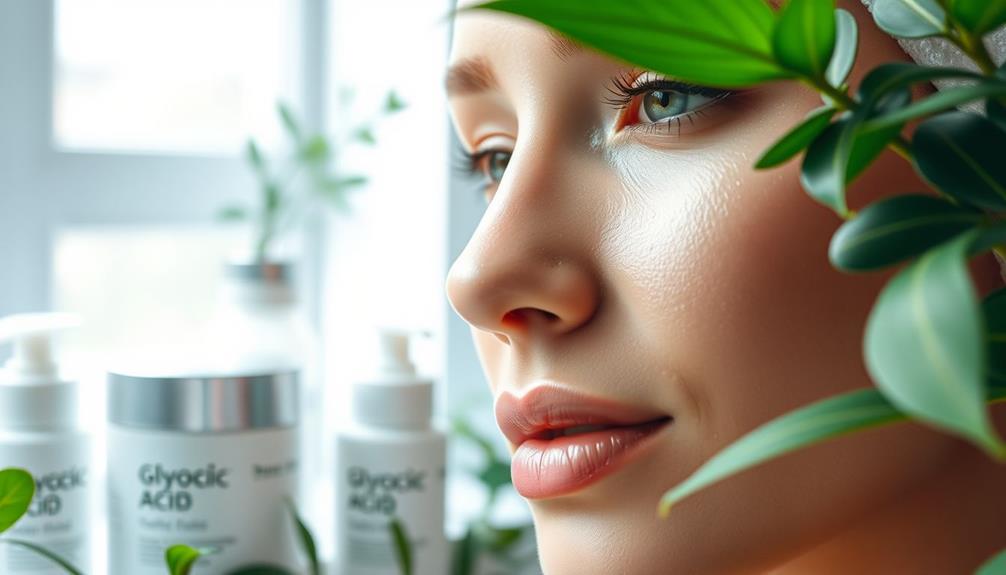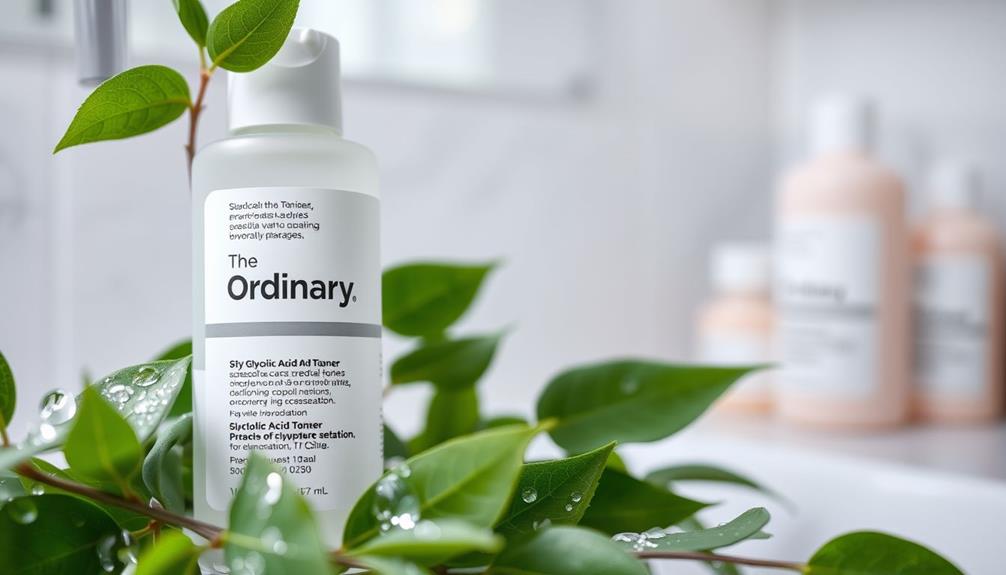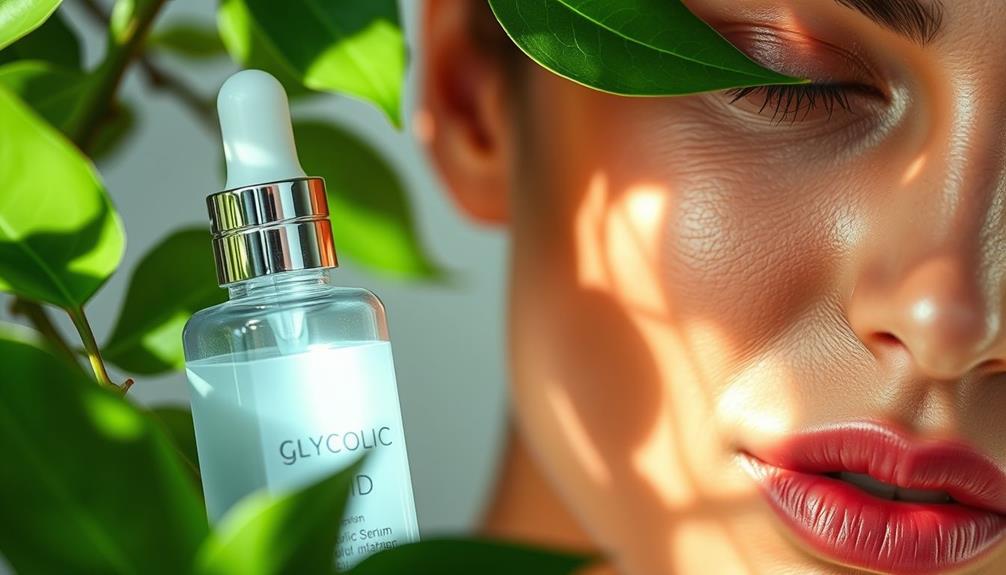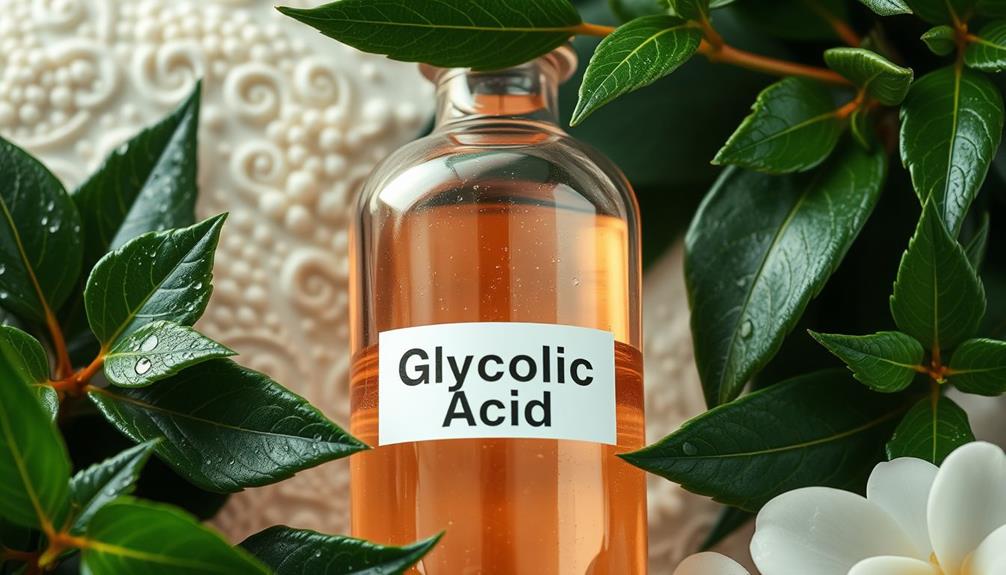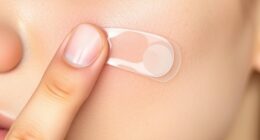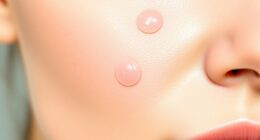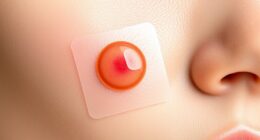Glycolic acid is a potent exfoliant extracted from sugar cane that can revitalize your skin. It effectively promotes cell turnover, helping with issues like acne, fine lines, and dark spots. By dissolving the bonds between dead skin cells, it reveals a smoother complexion while stimulating collagen production. Start with a concentration of 5-10% and apply it in the evening to minimize sun sensitivity. Remember to moisturize afterward to combat dryness and irritation. With the right approach, you can maximize its benefits, and there's plenty more to discover about incorporating it into your skincare routine.
Key Takeaways
- Glycolic acid is an effective exfoliant that improves skin texture, reduces fine lines, and addresses issues like acne and hyperpigmentation.
- Start with a concentration of 5-10% and apply it 1-2 times a week, gradually increasing frequency based on skin tolerance.
- Always use glycolic acid in the evening and follow up with broad-spectrum sunscreen during the day to prevent sun sensitivity.
- After application, hydrate your skin with a moisturizer rich in soothing ingredients to minimize irritation and support skin elasticity.
What Is Glycolic Acid?
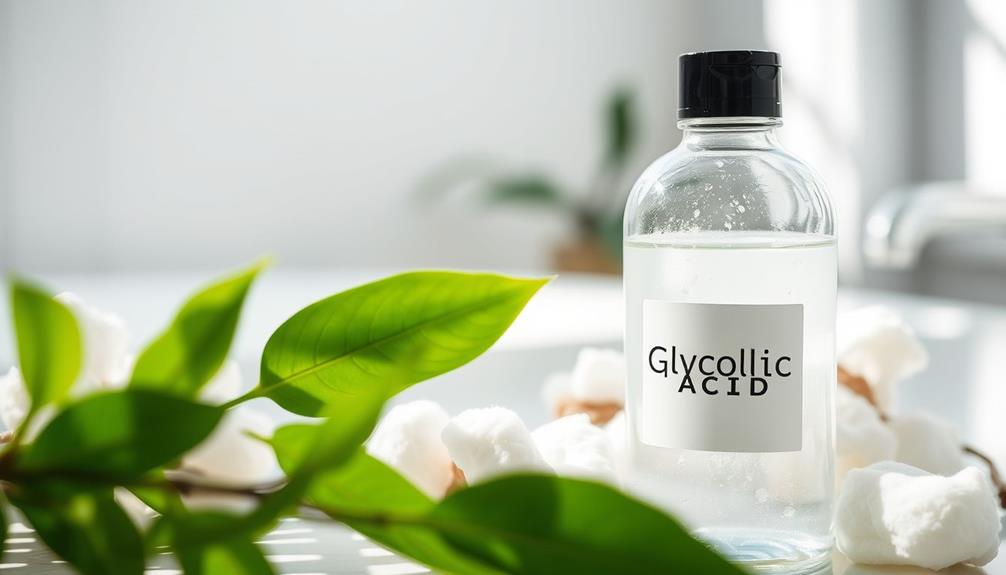
Glycolic acid, an alpha-hydroxy acid derived from sugar cane, is celebrated for its effective exfoliating properties that help rejuvenate your skin. This powerful acid works by penetrating deeply into your skin layers, making it unique among other AHAs.
When you use glycolic acid, it helps to exfoliate and remove dead skin cells, promoting healthy cell turnover. As a result, you'll notice a brighter and smoother complexion. Incorporating natural remedies like essential oils for skin health can further enhance your skincare routine and provide additional benefits.
One of the key benefits of glycolic acid is its ability to address various skin concerns. If you struggle with acne, glycolic acid can help unclog pores and reduce breakouts. It's also effective for tackling hyperpigmentation, helping to even out your skin tone by fading dark spots. Additionally, if fine lines and wrinkles concern you, incorporating glycolic acid into your routine can aid in minimizing their appearance.
You'll generally find glycolic acid in concentrations ranging from 5-10% in over-the-counter products, with stronger options available for professional chemical peels. By understanding what glycolic acid is and how it works, you can make informed decisions about your skincare regimen.
Benefits for Your Skin

Incorporating glycolic acid into your skincare routine offers numerous benefits for your skin, from enhancing texture to reducing fine lines and acne breakouts.
This powerful exfoliant works by dissolving the bonds that hold dead skin cells together, allowing your complexion to appear smoother and brighter.
Studies indicate that cats can recognize their owner's voice and scent, showcasing the importance of emotional connections, much like how glycolic acid fosters a renewed bond with your skin.
As glycolic acid encourages cell turnover, you'll notice an improvement in your skin's texture and tone over time.
Additionally, glycolic acid stimulates collagen production, which helps firm your skin and diminish the appearance of fine lines and wrinkles.
If you're dealing with hyperpigmentation, this acid can be particularly effective, as it helps fade dark spots by sloughing off excess pigment from your skin's surface.
For those prone to acne breakouts, glycolic acid clears clogged pores, making it a valuable addition to your regimen.
By promoting regular exfoliation and improved skin texture, you'll find that your skin not only looks healthier but also feels revitalized.
With consistent use, glycolic acid can transform your skincare routine, giving you a more radiant and youthful complexion.
How Glycolic Acid Works
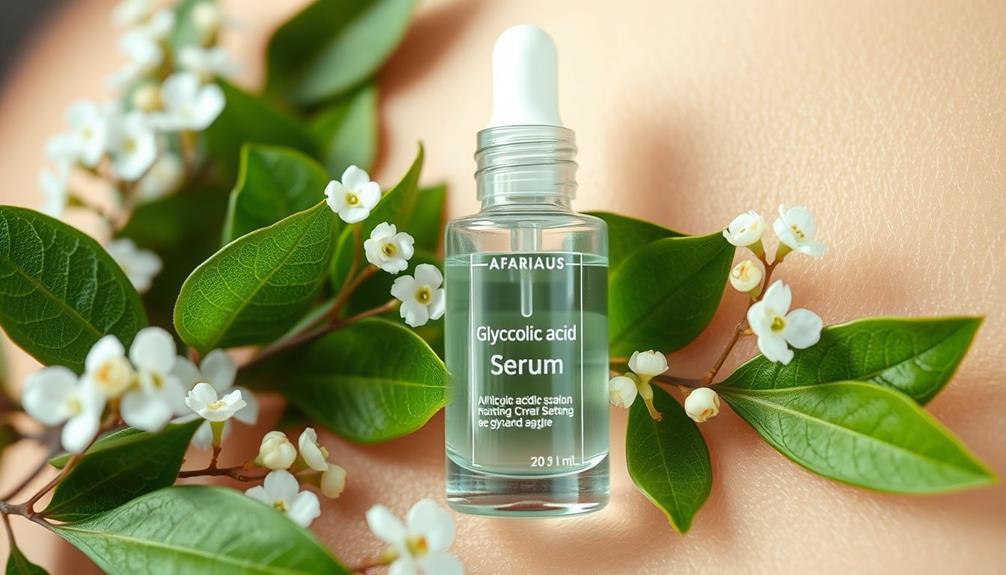
Understanding how glycolic acid works reveals its powerful ability to deeply exfoliate the skin by dissolving the bonds between dead skin cells. As the smallest alpha-hydroxy acid, glycolic acid penetrates effectively, accelerating cell turnover. This process promotes the shedding of old skin layers and stimulates fibroblasts to produce collagen, enhancing skin firmness and elasticity.
Additionally, incorporating essential oils for relaxation can complement your skincare routine by promoting overall well-being and reducing stress, which can be beneficial for skin health.
Glycolic acid comes in various concentrations, making it suitable for different skin types. At lower concentrations (5-10%), it provides gentle exfoliation, ideal for sensitive skin. Higher concentrations (30-40%) in professional peels offer deeper exfoliation and significant skin renewal.
Regular use can improve skin texture, brighten your complexion, reduce the appearance of fine lines, and help fade hyperpigmentation. In fact, epidermal thickness can increase by up to 27% over six months with consistent application.
To maximize its effectiveness, glycolic acid operates best at a specific pH level. Lower pH formulations enhance its exfoliating capabilities, so it's essential to choose products that meet these criteria for best results.
Incorporating glycolic acid into your skincare routine can lead to healthier, revitalized skin.
Application Guidelines
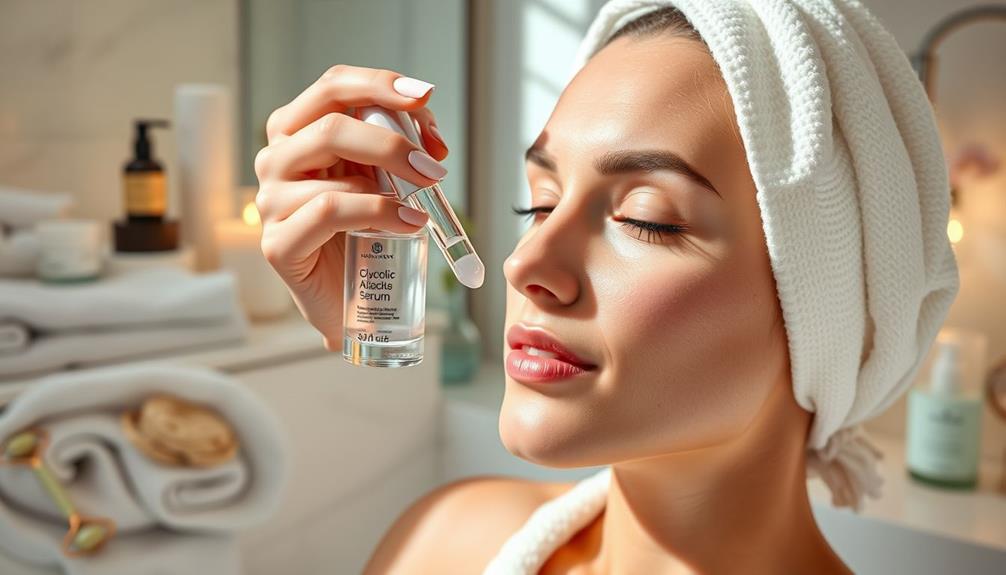
To achieve the best results with glycolic acid, it's important to follow specific application guidelines that suit your skin type and tolerance.
Start with a concentration of 5-10% to assess your skin tolerance. For first-time users, introduce glycolic acid into your routine 1-2 times a week, allowing your skin to rest between applications. You can gradually increase the frequency and concentration based on your skin's response.
Additionally, incorporating a consistent skincare routine that includes relaxation techniques, such as deep breathing or meditation, can enhance overall skin health and well-being, similar to how yoga can alleviate back pain.
Always apply glycolic acid products in the evening to minimize sun sensitivity, and remember to follow up with a broad-spectrum sunscreen during the day.
To prevent irritation, avoid mixing glycolic acid with other strong actives like retinoids or additional AHAs/BHAs.
Before fully applying any new product, conduct a patch test to verify compatibility with your skin. A gradual introduction to glycolic acid can help build your skin's tolerance, starting with gentler formulations.
Potential Side Effects

Glycolic acid can cause side effects like redness, stinging, and dryness, especially during the initial use or at higher concentrations. If you have sensitive skin, you might notice increased sensitivity or more pronounced reactions.
It's important to start with lower concentrations, typically between 5-10%, to minimize these risks. Overusing glycolic acid can lead to chemical burns or severe irritation, so following recommended usage guidelines is essential.
To help prevent any adverse reactions, consider patch testing before applying glycolic acid to your entire face. This allows you to assess your skin's tolerance and make adjustments as needed.
Another vital point to keep in mind is that glycolic acid increases your skin's sensitivity to the sun. As a result, you should always apply a broad-spectrum sunscreen with at least SPF 30 during the day to protect your skin from UV damage.
Best Practices for Use
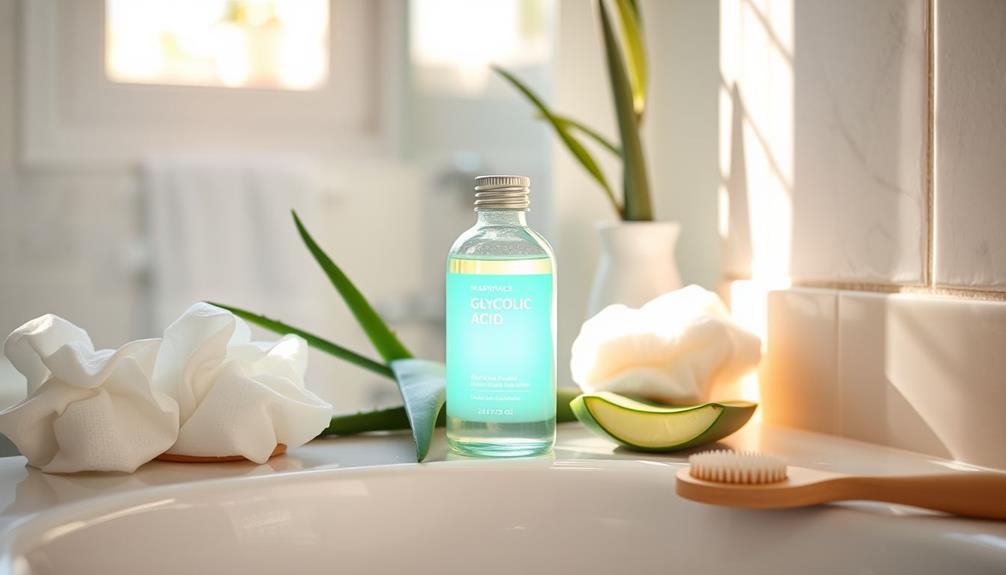
When using glycolic acid, it's important to start slowly to allow your skin to adjust.
Always follow up with a moisturizer to keep your skin hydrated and minimize irritation.
With the right approach, you can enjoy the benefits of glycolic acid without overwhelming your skin.
Start Slowly
Start with a glycolic acid concentration of 5-10% and limit your initial applications to just 1-2 times per week to gauge your skin's tolerance. It is crucial to start slowly to avoid irritation and skin sensitivity. Gradually increase the frequency of use as your skin adapts, aiming for a maximum of every other day.
Before diving in, always perform a patch test on a small area of skin to assess for any adverse reactions. You'll want to keep an eye on how your skin reacts, especially regarding sun sensitivity. It's best to incorporate glycolic acid into your nighttime routine and always follow with a broad-spectrum sunscreen during the day for protection.
Here's a helpful table to visualize your approach:
| Step | Action |
|---|---|
| 1. Start Slowly | Use 5-10% concentration |
| 2. Initial Applications | 1-2 times per week |
| 3. Assess Tolerance | Monitor for irritation and sensitivity |
| 4. Patch Test | Test a small area before full application |
| 5. Increase Frequency | Gradually increase to every other day |
Follow With Moisturizer
Following glycolic acid application, it's important to apply a moisturizer to help restore hydration and protect your skin barrier. Glycolic acid can increase skin sensitivity, making it crucial to use a product rich in hydrating ingredients like ceramides and hyaluronic acid. These components not only help soothe any irritation but also enhance overall skin hydration, improving the effectiveness of your treatment.
Apply your moisturizer immediately after using glycolic acid to lock in moisture and prevent trans-epidermal water loss. Opt for a fragrance-free moisturizer formulated for sensitive skin to further minimize the risk of irritation, especially during the post-exfoliation phase. This step is significant for maintaining skin health, as consistent hydration supports skin elasticity and helps prevent signs of aging.
Incorporating a quality moisturizer into your routine after glycolic acid use promotes long-term skin health. By prioritizing hydration, you'll guarantee your skin barrier remains strong and resilient, allowing you to enjoy the benefits of glycolic acid without compromising your skin's comfort.
Product Recommendations
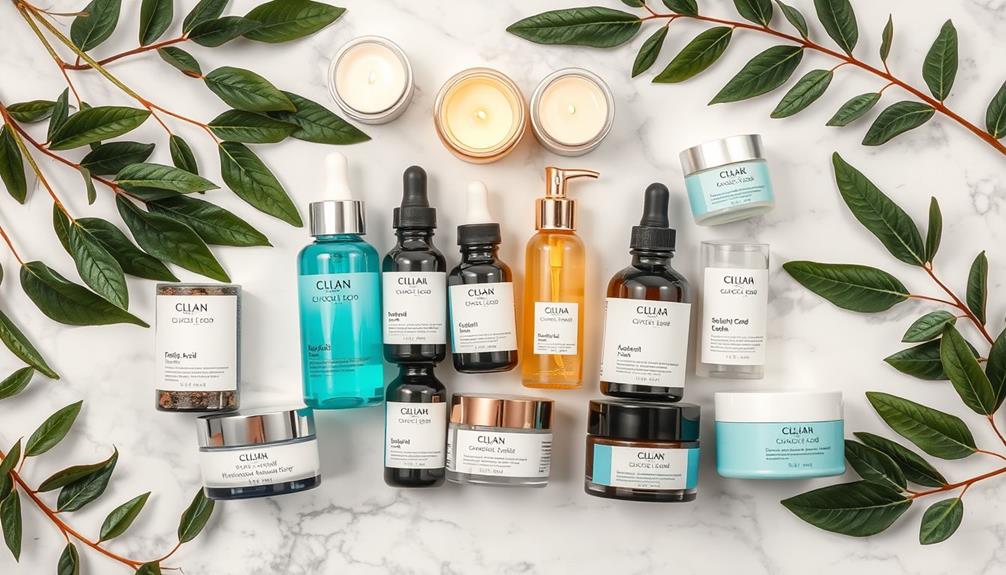
For beginners, choosing glycolic acid products with a concentration between 5-10% can effectively exfoliate your skin while keeping irritation to a minimum. Look for cleansers that combine glycolic acid with hydrating ingredients, which help balance the exfoliating effects and make them suitable for sensitive skin types.
For a more targeted approach, popular glycolic acid serums typically feature lower pH levels, enhancing their efficacy in promoting cell turnover and improving skin texture.
If you prefer convenience, glycolic acid pads offer a great option for at-home use. They simplify the process of incorporating this chemical exfoliation into your routine, providing controlled application and consistent results. Just be mindful of how your skin reacts, especially if you're new to exfoliating ingredients.
If you're seeking deeper exfoliation, consider professional-grade glycolic acid peels, which contain concentrations of 30-40%. However, these should only be done under dermatological supervision for significant skin improvements.
Conclusion
Incorporating glycolic acid into your skincare routine can be a game-changer for achieving glowing, gorgeous skin.
By gently exfoliating and rejuvenating, it helps reveal a fresh, fabulous complexion.
Just remember to start slowly, follow the best practices, and keep an eye out for any side effects.
With the right approach, you'll unearth the potential of this powerful ingredient and transform your skincare journey into a radiant revelation.
Embrace the beauty of glycolic acid today!
